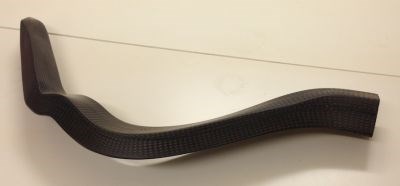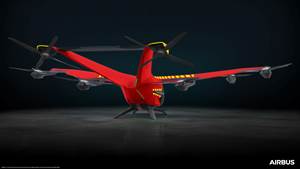Highlights: JEC Europe 2014
Composites enable high performance and lower weight in washtubs, wheelchairs and engine exhaust cones. Plus new, ultralight materials.

Composites enable high performance and lower weight
in washtubs, wheelchairs and engine exhaust cones.
In situ consolidated thermoplastic composites for aircraft structures
FIDAMC (Madrid, Spain) and MTorres (Navarra, Spain) have developed technology which enables the automated layup and in situ consolidation of carbon fiber reinforced polyetheretherketone (PEEK). The unique equipment and process — including real-time temperature monitoring — has resulted in composites with 35 to 40 percent crystallinity in the matrix and sufficient degree of consolidation (DOC) to require no further heat, vacuum bag or autoclave processing. Currently, real-time temperature control is being integrated into the equipment. Materials involved to date have been supplied by Cytec (Woodland Park, N.J., USA) and Toho Tenax (Wuppertal, Germany).
CMC exhaust cone for LEAPX engines


The Aquitaine region of France displayed a model of the ARCOCE (ARrière-Corps Composite Ceramique, or afterbody ceramic composite) engine exhaust cone designed and built by Herakles (Le Haillan, France), a subsidiary of Safran (Paris, France). The ARCOCE is comprised of two separate structures: the cone-shaped plug or centerbody and a corrugated mixer, designed to thoroughly mix engine bypass air with the turbine exhaust.
When Herakles (Safran) developed an engine fitted with an exit cone made from ceramic matrix composites (CMCs) in 2012, it reportedly achieved a world first. Herakles describes CMCs as opening up possibilities in thermostructural composite materials, due to their high temperature service ability, up to 1,500°C (2732°F). Currently being tested on a CFM56 engine, the ARCOCE prototype measures 1625mm (5 ft) in length and 655mm (2 ft) in diameter, weighing 24.5 kg (54 lb).
According to Yann Richard, CMC Exhaust program manager for Herakles, "Up until now, we’ve only ever used this type of thermostructural material for military aircraft. Like all disruptive technology, this requires thinking in the very long term. We started to look closer at applications for commercial aircraft in order to produce a series of parts for the next generation of LEAP engines, in addition to the new engines designed by Safran in the run up to 2020-2030."
Herakles reports that CMCs are set to replace many of the metal parts currently used in the hot zone, offering 30 to 50 percent weight savings and reduced CO2 emissions.
The prototype CMC mixer was developed as part of a technology demonstration program in conjunction with two other Safran Group companies, engine manufacturer Snecma (Courcouronnes, France) and nacelle manufacturer Aircelle (Le Havre, France). It was co-funded by France’s CAA, or Civil Aviation Authority, also known as the Direction Générale de l'Aviation Civile (DGAC, Paris, France). This component successfully completed endurance and performance tests in 2005 on a test bed at Snecma’s R&D facility in Villaroche, France. Fastening directly to the aft flange of the engine’s turbine frame, and interfacing with the nacelle, the mixer improves the output from and efficiency of the engine’s exhaust system. Its complex “lobed” shape ensures optimal mixing of the hot gases from the engine with the cold bypass air.
The ARCOCE prototype exhibited was developed and manufactured for a CFM56-5B/5C turbine engine in 2008 to 2010, underwent 53 hours of engine ground tests in 2011 (vibratory stress, endurance and acoustic performance testing) and 18 hours of flight tests on an Airbus A320 flying test bed in 2012. Certification via the European Aviation Safety Agency (EASA, Cologne, Germany) was to be completed in 2013 and the prototype is scheduled to undergo a 5,000-hour Air France flight campaign from 2014 to 2016.
Henkel Surfacing Film Provides LSP with Less Weight on Bombardier Learjet 85

Henkel (Toulouse, France and Bay Point, Calif.) displayed its LOCTITE EA 9845 EC lightweight surfacing film with expanded copper foil lightning strike protection (LSP) which reportedly offers a 30 percent weight reduction versus previous products. The epoxy-based product cures at 120°C to 176°C (248°F to 349°F) and reportedly reduces surface imperfections and pre-paint surface prep. while boosting UV and chemical resistance. The Learjet 85 tailcone section shown above is manufactured by Bombardier in Querétaro, Mexico, which has qualified this system for use across the aircraft's fuselage.
Ultra-lightweight (2 gsm !) carbon fiber veils
Technical Fibre Products Ltd. (TFP, Burneside Mills, U.K.) and Technical Fibre Products Inc. (Schenectady, N.Y., USA) also featured lighter weight layers via the newest Optiveil carbon fiber veil weighing only 2 g/m2 (gsm) or 0.1 oz/yd2. The Optiveil product line ranges up to 400 gsm and is used for electrical conductivity, EMI shielding, stabilization for fragile reinforcements and as an adhesive substrate. TFP also claims the veils can be used to increase fracture toughness in composite laminates.
New glass/PP washing machine tub increases spin speed by 50 percent and adds 30 percent more capacity per washload.

One of the leading appliance OEMs in Europe was seeking faster spin speeds, greater capacity and improved durability in its washing machines for the Russian market. However, the traditional tub composition of polypropylene (PP) reinforced with either 40 percent filler or 30 percent chopped glass fiber was not able to deliver a solution. Thus, the OEM turned to thermoplastic composites producer, Polyplastic Group (Moscow, Russia), who then worked with Owens Corning (Gous-Khroustalny, Russia and Toledo, Ohio, USA) to develop a new PP composite using PERFORMAX 249 chopped glass fiber. Though glass content stayed at 30 percent, PERFORMAX 249 enabled improved flow in the injection molding process and better fiber-polymer adhesion, resulting in 15 percent higher strength and stiffness. This, in turn, enabled thinner tub walls, 30 percent more capacity without increasing the tub size and spin cycles up to 1,500 rpm versus the norm of 1,000 rpm. The new design also won the JEC 2014 Innovation Award in the Consumer Goods category.
The OEM sees a large potential for this type of high-performance development, not only in Russia — the fourth largest market in Europe for household appliances — but in Europe overall, projecting an annual growth of 15 percent thanks to demand for higher efficiency/higher value white goods.
Lightweight, tailorable wheelchair made affordable in CFRP without tooling.

Far Composites (Nottingham, U.K.) is working with a Liverpool-based company, which specializes in lightweight, bespoke wheelchairs that are adjustable for active users. Their goal is to develop a novel forming process, together with AXONTEX technology for carbon fiber beams and shaped structures, to produce very light, customized wheelchairs at an affordable price by eliminating one-off tooling.

Exmaple of intricate shapes reportedly possible without tooling using AXONTEX.
Medical experts agree that custom fitting a wheelchair to its user not only improves comfort, but minimizes energy expenditure and reduces stresses on the body. “Our technology fits perfectly with the need to tailor wheel axle location, wheel camber, and the angle of the seat beams,” says Far-UK Ltd. general manager, Lyndon Sanders. “We’ve developed prototypes for designs that our client can make using either prepreg or infusion without tooling,” he adds, noting that the next step will be full-scale manufacture. Far Composites provides several options: train the client to make the parts in-house, work with them to establish a qualified supplier or supply them directly, according to their preference.

The AXONTEX technology was previously recognized via Far-UK subsidiary, .'sAxon Automotive Ltd (Wollaston, U.K.) 2012 JEC Innovation Award for its carbon fiber composite Body in Black (BiB) system. Weighing 50 kg (110 lb) for a city car to 80 kg (176 lb) for a medium sedan, the AXONTEX BiB system reportedly provided all of the stiffness and crash compliance required while allowing external body panels of any material, for example: steel, aluminum or thermoplastic. Crestapol 1250 LV, a new urethane acrylate resin for RTM and vacuum infusion was developed with Scott Bader (Wollaston, U.K.) and was used to reduce cost and improve toughness.
Related Content
Filament winding increases access to high-performance composite prostheses
Steptics industrializes production of CFRP prostheses, enabling hundreds of parts/day and 50% lower cost.
Read MoreEvonik showcases chopped carbon fiber-reinforced PEEK filament
Vestakeep is available at two levels of carbon fiber content and appropriate for long-term surgical implants.
Read MoreAMSL Aero partners with CareFlight for Vertiia aeromedical fit-out
Together, AMSL Aero’s long-range eVTOL aircraft will enable CareFlight to provide direct services from remote sites directly to hospitals.
Read MoreCityAirbus NextGen to be developed for future medical missions in Norway
Airbus and the Norwegian Air Ambulance Foundation partner to measure the added value of eVTOL aircraft for medical use cases across Norway.
Read MoreRead Next
“Structured air” TPS safeguards composite structures
Powered by an 85% air/15% pure polyimide aerogel, Blueshift’s novel material system protects structures during transient thermal events from -200°C to beyond 2400°C for rockets, battery boxes and more.
Read MoreVIDEO: High-volume processing for fiberglass components
Cannon Ergos, a company specializing in high-ton presses and equipment for composites fabrication and plastics processing, displayed automotive and industrial components at CAMX 2024.
Read MorePlant tour: Daher Shap’in TechCenter and composites production plant, Saint-Aignan-de-Grandlieu, France
Co-located R&D and production advance OOA thermosets, thermoplastics, welding, recycling and digital technologies for faster processing and certification of lighter, more sustainable composites.
Read More






















